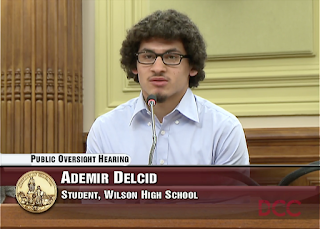This morning, the Council of the District of Columbia's
Committee on Labor and Workforce Development had their Performance Hearing for the
Department of Employment Services and the
Workforce Investment Council. Amy Dudas, one of our Policy Analysts, provided testimony.
***
Good morning
Chairperson Silverman, fellow councilmembers and committee staff. My name is Amy Dudas and I am here to testify on behalf of the DC Alliance of Youth Advocates (DCAYA), a coalition of over 130 youth-serving organizations operating here in the District to provide our feedback and recommendations to this committee on DOES and the WIC.
I’d like to open my testimony by acknowledging the continued commitment of both DOES and the WIC over the last year to foster inter-agency collaboration , integrate program design for special populations, and to encourage high standards across the District’s workforce agencies. We have been happy to see continued planning and early benchmarks met in the implementation of the Workforce Innovation and Opportunity Act (WIOA). DOES has laudably enhanced the diversity of its services to special populations of youth, including youth with disabilities. As the agency continues this important work, we encourage the training of agency staff to ensure that accessibility is maximized and youth disclosure considerations are handled appropriately. Additionally, the WIC should be leveraged in its oversight and coordination role to ensure this more diverse youth portfolio is streamlined and strategically designed across federal and local funding streams in the coming year. With that, I’d like to turn my testimony to some specific pieces of feedback from 2016 and targeted recommendations for the year to come.
Marion S. Barry Summer Youth Employment Program (MBSYEP):
At a projected investment of $17.1 million for FY16 and serving nearly 14,000 youth, the DOES-administered Marion S. Barry Summer Youth Employment Program (MBSYEP) continues to represent the District’s largest investment in youth workforce development, and an important entry point into the District’s broader workforce system. In highlighting any shortcomings in this testimony, we aim to bolster the improvement plans we know are already underway for program year 2017.
Ensure Quality Placements
DOES continued to identify areas of potential MBSYEP quality improvement in FY16. Selected as a 2016 Summer Impact Hub by the White House, the agency was supported in its goal to secure 1,500 private sector slots for youth with the addition of 23 new participating businesses. Along this vein, DOES must continue to work to cultivate effectively prepared and diverse host sites and recruit future host sites on the basis of quality . We are encouraged to hear that DOES has plans underway to emphasize the development of SYEP curricula with host sites through Host Employer workshops, and hope this strategy will be maximized to ensure consistent quality across all host sites.
Leverage Expansion
The 2016 SYEP also saw the continued program expansion to serve up to 1,000 youth ages 22-24. DCAYA hopes to see this especially vulnerable population of older youth with self-reported difficulty accessing the labor market connected with appropriate next-step options at the conclusion of this summer opportunity. To maximize the benefit of the MBSYEP expansion to youth ages 22-24, we hope to see the continued emphasis on tracked outcomes in the form of intentional and successful handoffs between SYEP and employment, training and/or education. Last year, the MBSYEP Summer Report was tremendously helpful in ensuring these efforts were executed to high standards of quality and transparency, and we encourage the continuation of this annual publication as a way to demonstrate progress towards those goals.
Maximize the District’s Investment
Given SYEP’s expansive reach (it serves 60% of DC youth aged 14-21) and cost (almost $17.1 million dollars in local funding), it is imperative that the MBSYEP become an outcomes-driven program with well-articulated roles for all stakeholders. We recommend that the DC Auditor’s evaluations be replicated by a third party expert in program year 2017 to support DOES in reaching these goals . Further, we echo the DC Auditor’s recommendation that DOES can more effectively collaborate with DCPS, the Charters and OSSE to ensure connectivity between the MBSYEP experience, summer bridge programs, CTE coursework and year-round employment opportunities. Some of this planning is included in the District’s Draft WIOA State Plan, but we hope the summer of 2017 will provide the opportunity to further implement these plans.
Youth Workforce Development Programs/ WIOA Youth Programs:
Improve Transparency of WIOA Contracting Process
In FY16, the District successfully ramped up program enrollment to 207 OSY and 90 ISY participants through the implementation of Human Care Agreement contracting process. While this increased participation marks a turning point in the District’s federally-funded youth programming, it remains unclear which local providers have received contracts to provide these services, how many youth are being served in each program, and if these programs are aligned with the educational and training needs of youth or the District’s growth industries. The Department of Labor will start holding states publically accountable to performance outcomes starting in the summer of 2018, but DOES should be using this interim period to work with the WIC to ensure that quality, aligned and compliant programs are in place. It is also important to note that without a clear, shared vision of how the District’s youth workforce development system should be enhanced over time, providers are unable to make organizational planning and investment decisions that align with District-wide youth workforce development goals.
Streamline Contracting Process
While Human Care Agreement (HCA) contracts have proven a helpful tool in designing a diverse workforce system from the perspective of the District’s workforce agencies, it is important to acknowledge the challenges they can pose for providers. The HCA process is often lengthy as it moves through multiple phases. To a prospective contractor, deadline windows are usually only a couple of weeks, while waiting for a next step of the process to begin can take months. Though we still think the HCA process is a key tool in the design and responsiveness of the District’s youth workforce development system, we hope to see its administration and timeliness improve into FY17 and beyond.
Utilize WIC Oversight and Diverse Stakeholders to Streamline the Youth System
With WIOA’s emphasis on serving the most vulnerable workers, expanding education and training options, helping disadvantaged youth earn while they learn, and aligning planning and accountability polices across core programs, the District will be required to further alter the design of our current workforce programming. The WIC must be positioned to lead and coordinate the city’s strategic vision for its workforce system, with authority to direct both local and federal funding.
Beyond these top-down stakeholder considerations, it’s also important to emphasize the critical role that youth and youth providers play in bringing unforeseen implementation challenges to the forefront, piloting new strategies, and representing the real-time needs and priorities of the youth. Moving forward, we hope the newly established Youth Committee of the WIC will continue to engage community, business, provider, and youth representatives in its work to maximize the effectiveness and connectivity of the District’s youth workforce development programs. Creating consistent opportunities to understand the decision-making process of government partners, garner the buy-in of diverse stakeholders, and voice concerns can go a long way in building the cohesive, data-driven, and holistic system of workforce development with, and for, youth.
Thank you, and I’m happy to answer any questions you may have.
***
If YOU have any questions about this, please
feel free to email us.
And if you are looking for more ways to involved in Youth Advocacy, as an individual or part of a community based, youth-serving organization, consider joining us in just two weeks at our
Youth Advocacy for Action Summit!
And thank you to the following Sponsors who helped make this event possible.






























